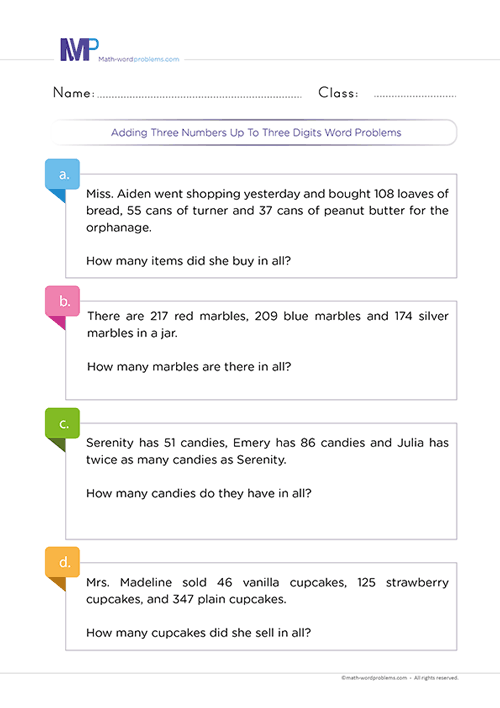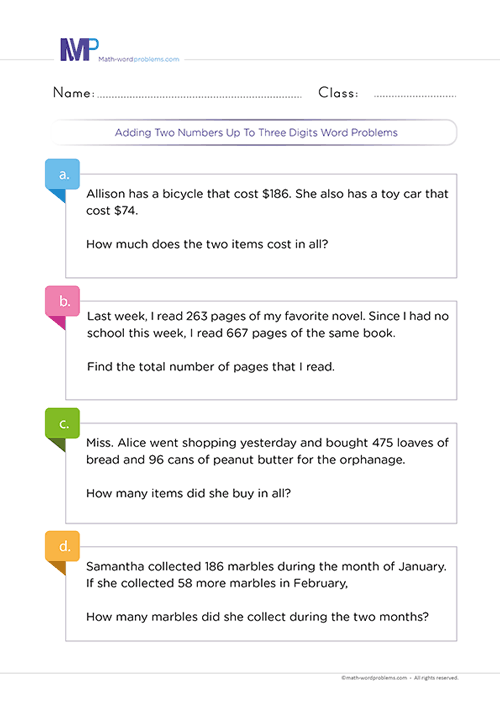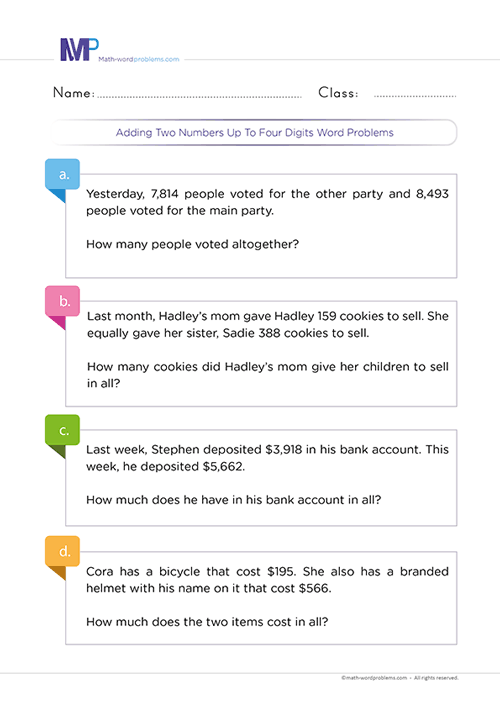 How to perform addition of three numbers up to three digits word problems
How to perform addition of three numbers up to three digits word problems

- INTRODUCTION
- Step 1 Identify
- Step 2 STRATEGIZE
- Step 3 SET UP
- Step 4 PROVIDE A SOLUTION
- Step 5 CHECK YOUR WORK
Get more contents on this skill...
Our step-by-step guide below on how to perform addition of three numbers up to three digits word problems will offer your kids the skills they need to solve addition problems efficiently.
In a bid to design a unique word problem-solving guide on adding numbers, we will provide kids with the best way to identify the problem structure and use their mental composition to represent and solve the problem accurately.
In order words, this fun design will improve third graders' skills to perform addition of three numbers up to three digits word problems in a more fantastic way.
Steps on how to solve addition of three numbers up to three digits word problems
These unique steps on how to solve addition of three numbers up to three digits word problems are here to provide your kids with the up-to-date mathematical skills they need.
These unprecedented steps aim to elaborate on the general problem-solving procedure of reading the problem to understand, identify, represent the problem type, plan, provide an accurate solution, and check to ensure the procedure and the answer are correct.
In line with this, we will model a few examples with steps on steps on how to perform addition of three numbers up to three digits word problems.
Step 1 IDENTIFY THE PROBLEM
To identify the problem,
- First, you must read the problem between the lines to understand it.
- Then, identify and underline relational statements.
- Now, reread the problem and try to sort out actual numbers and keywords in the problem.
As for keywords, here are some common keywords that you will see when you come across addition word problems: add, plus, more, total, increase, together/all together, combined, sum, grow, join, both, in all, altogether, how many in all, how much, and, etc.
Note: learners should understand that it would be best not to rely entirely on keywords alone because a particular keyword can have different meanings in different word problems.
In that case, you need to read the question very well to understand the situation the word problem describes. After reading, you will also find out if the problem makes sense first before determining which operation you need to use.
Step 2 STRATEGIZE AND DETERMINE THE OPERATIONS
Now, ask yourself, “How will I tackle this problem?”
At this juncture, kids must apply the read-to-understand rule. i.e., they’ll have to read the word problem and retell it using their own words.
Furthermore, since each word problem may require a different solving scheme, thekey points below will enable young math learners to tackle any scheme a word problem may present.
- First, the keyword in the word problem will help clarify the operation that you need to carry out.
- However, as mentioned above, relying on keywords alone to solve word problems has some limits.
- First, you have to read the word problem to understand the situation that the problem is describing.
- Reading the problem well will enable you to identify the problem type and relational statement, which, together with the problem’s keyword(s), will determine the accurate math operation needed.
Step 3 SET UP A NUMBER SENTENCE AND AN EQUATION
- After knowing which operation you will perform from step 2 above, construct short phrases representing the information given in the word problem.
- These short phrases or sentences represent the vital information that makes it easier to solve the word problem. In order words, it is like a diagram of the word problem.
- Now, you can deduce a solvable maths equation to represent the information given in the phrases you constructed above.
Step 4 SOLVE THE PROBLEM
After writing down the maths equation, you can solve the problem using any addition method of your choice, preferably the column method. Furthermore, always add the unit of measurement to the final result
Step 5 VERIFY YOUR ANSWER
Finally, check your work to make sure that your answer is correct. For instance, since you are dealing with only numbers and not algebraic expressions, it is good to use reasonableness by estimation to see if your answer makes sense.
So, if you estimate and the answer is close to the one you have, then your answer is correct. However, if your answer is outrageous, you must go back to step one and start over again.
Examples of how to add three-digit numbers up to three digits word problems
Example One
Step 1: After reading the problem and underlining the relational statement, the keyword that you will find in the word problem is “altogether.”
Step 2:Next, ask yourself, “How can I solve this problem?”
First, what is the problem trying to say?
The problem is that if you take the days of September, October, and December and join together, how many days will you have?
Also, the problem indirectly tells that you have to have a mastery of the number of days each month has before you can successfully solve it.
Now, the question should be:- which operation can join three similar things into one?
So you see, from the situation that the problem is describing, and from retelling the problem in your own words and from the keyword “altogether” found in the word problem indicates that you have to perform an addition operation.
Step 3: Construct short phrases representing vital information in the word problem.
Also, write down a solvable maths equation to represent the information given in the sentence that is in bold below.
- Number of days in September = 30
- Number of days in October = 31
- Number of days in December = 31
- Therefore, the total number of days these months have = the number of days in September + the number of days in October + the number of days in December.
→ 30 + 31 + 31 =?
Step 4: Last but not least, from step 3 above, stack the values in the equation you formed so that their place values should line up. Then, go ahead and add the values using any method of addition method preferably column addition. Also, always include the unit of measurement in the final result.
So, there are 92 days altogether in September, October, and December.
Step 5:Finally, check your work to ensure your answer is correct. Since you are dealing with only numbers and not algebraic expressions, it is good to use reasonableness by estimation to see if your answer makes sense.
So, if you estimate and the answer is close to the one you have, then your answer is correct. However, if your answer is outrageous, you must go back to step one and start again.
Example Two
Step 1:After reading the problem and underlining the relational statement, you will realize that this problem is a little challenging. Also, the keyword in the word problem is “total.”
Step 2:Next, ask yourself, “How can I solve this problem?”
Now, you need to first interpret the problem in your own words, excluding any numbers.
The problem is narrating how Mrs. Nelson is explaining the ages of her children in a comparable way. Ultimately, the problem wants you to join all the children’s age.
Also, you should remember that only one child’s exact age is given. So you need to work a little extra hard to come out with the real ages of the rest of the children.
Now, the question should be:- which operation can join three similar things into one?
So, you see that, from the situation that the problem is describing, from retelling the problem in your own words, and together with the keyword found in the word problem, you need to perform an addition operation.
Step 3:Construct short phrases representing the most vital information in the word problem.
Next, write down a solvable maths equation to represent the information given in the sentence that is in bold below.
- Mikkel’s age = 5 years
- How old is Jonas as compared to his youngest brother = 15 years older than his brother
- Jonas’ age = Jonas’ age compared to his youngest brother + Mikkel’s age
15 + 5 = 20 years
- How old is Juanita as compared to her youngest brother = 10 years older than her brother
- Juanita’s age = Juanita’s age compared to her youngest brother + Mikkel’s age
10 + 5 = 15 years
- Therefore, their total age = Mikkel’s age + Jonas’ age + Juanita’s age
→ 5 + 20 + 15 = ?
Step 4: Finally, from step 3 above, stack the values in the equation you formed, so their place values line up. Then, add the values using any addition method, preferably column addition. Also, always add the unit of measurement to the final result.
So, their total age is 40
Step 5:Finally, check your work to ensure your answer is correct. For instance, since you are dealing with only numbers and not algebraic expressions, it is good to use reasonableness by estimation to see if your answer makes sense.
So, if you estimate and the answer is close to the one you have, then your answer is correct. However, if your answer is outrageous, you must go back to step one and start over again.





